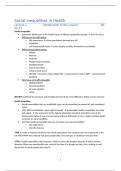Social Inequalities in Health
Lecture 1 Introduction to the course 04-
09-23
Health inequality
Systematic differences in the health status of different population groups over the years.
Differences in health status
o Life expectancy some populations become less old.
o Morbidity
o Self-rated health status some people consider themselves less healthy.
Different population groups
o Elderly
o Woman
o Students
o People living in poverty
o Disabled people
o Sexual minorities
o Living in rural area’s
o SES/SEP = resources and prestige (SES = socioeconomic status) (SEP = socioeconomic
position)
Why focus on health inequality
o Global problem
o Growing problem
o No easy solution
o Unfair
SES/SEP is defined by resources and prestige and one of the most difficult to define and to measure.
Health inequities
Health inequalities that are modifiable (you can do something to prevent it) and considered
unfair.
1946 WHO constitution: ‘equal right to health’ preventable health inequalities are unfair
and unjust. the enjoyment of the highest attainable standards of health is one of the
fundamental rights of every human being without distinction of race, religion, political belief,
economic or social condition.
Are there health inequalities that are not unfair and not preventable?
o Life expectancy
o Genetic diseases
1948: In order to improve health for the whole population, free medical care was introduced in the
UK. After WWII they noticed that poor people died a lot younger, so healthcare became free.
1970’s: health inequalities had increased. It did not solve the problem because it didn’t prevent
diseases. When you need health care, most of the time it is already too late. Also, nothing is said
about how to reach people who need it.
1
,1980: The Black Report
Social class statistics
Explanations:
o Selection if you are fit and healthy you are able to take on a good job so take on a
high social position.
o Artefact people in manual jobs (lower social class jobs) are usually older people,
so the difference is because the age generation.
o Material/structural material matters explain the differences doing factory work,
bad housing, bad pollution.
o Behavioural-cultural people who work in factories tend to drink and smoke more
for example.
Recommendations were not well received by the government because this meant that the
government had to spend money in order to limit the differences.
The Black Report became nevertheless a landmark document.
1998: The Anchenson Report
Social gradient effects
o Not the poor vs. the rich in every step of the social class ladder, health improved.
But it increased a lot more in the higher social classes. This was hard to explain
looking at the material causes, because why would a nicer office mean better health.
o Psycho-social causes being in a higher position gives less stress and is therefore
better for your health.
2023:
Still no decline in health inequalities
Causes are still not fully understood
Effective solutions are not in place
Bartley: identity
Stable identity vs. threatened identity when growing up in a loving family with safety and
without competition gives a stable identity.
Consumption as a substitute (symbolic goods, drugs, and comfort foods) happens when you
have a threatened identity.
Increase in identity threat because of:
o Individual freedom (no religion or gender roles). In the past, religion told you what to
do and how to act and religion becomes less relevant. Gender roles also change,
because nowadays it is not necessarily true that girls become housewives and boys
get jobs.
o Social media people have a lot of opinions, and you see what cool stuff other
people have and get influenced by it.
Kate Pickett: consumerism
More inequality leads to higher consumption, which is bad for the environment.
2
, Lecture 2 Behavioural and cultural explanations for health
inequalities 08-09-23
The issue (again)
Health inequalities
o Not declining over the last few decades; even
increasing
o Despite free access to health care
o More inequality in egalitarian countries (e.g.,
Scandinavia)
Health is politicized: health ‘facts’ and explanations
for health inequality have political implications and gain media attention.
Main questions
To what extent do socioeconomic differences in health behaviours explain socioeconomic
health differences?
How can we explain (and thus intervene in) socioeconomic differences in health behaviours?
Behavioural explanation
Lower SES is associated with poorer health behaviours and health inequality (the Black
Report, Townsend et al., 1986; Adler et al. 1994; Marmot et al. 1987; Hanson & Chen 2007;
Fukuda, Nakamura & Takano, 2005).
Higher likelihood of exposure to risk behaviours, such as smoking, excessive alcohol
consumption, physical inactivity,
poor diet, and nonattendance of
health check-ups. (Fukuda,
Nakamura & Takano, 2005).
SEP and behaviour: debate about effect
sizes
Bartley (2017): emphasizes trends in competing explanations.
o It is not sure whether it is material, psycho-social and behavioural
o Policy implications of the ‘best’ explanation
o Bartley tends to downplay the role of behaviour (“only around a third of the
differences in mortality risk”, p. 85)
Percentages range from 24% to 72% (Stringhini et al., 2010)
In France, 17% (Stringhini et al., 2011)
o “A very important result which did not receive the amount of attention it deserved”
(Bartley, 2017, p. 86) other people see this result as outlier.
Observational studies; mixed evidence; researchers acquire ‘bias’
Explanations according to Bartley
3




